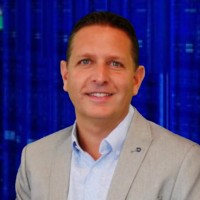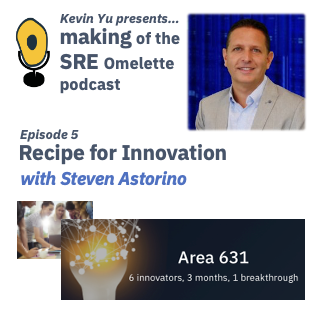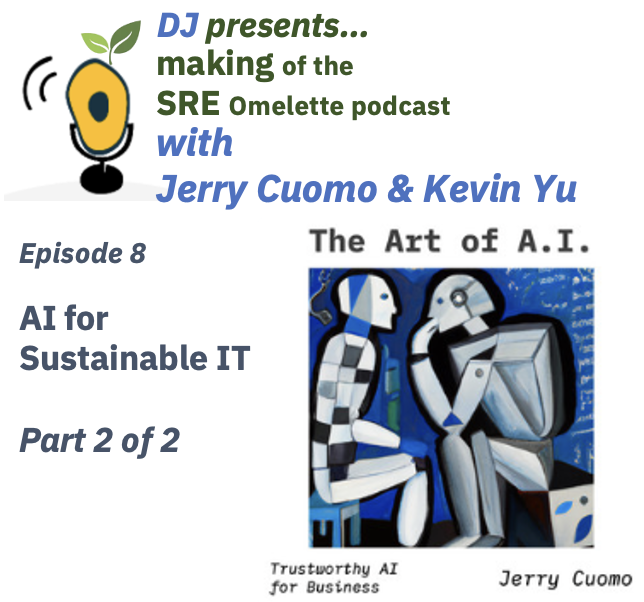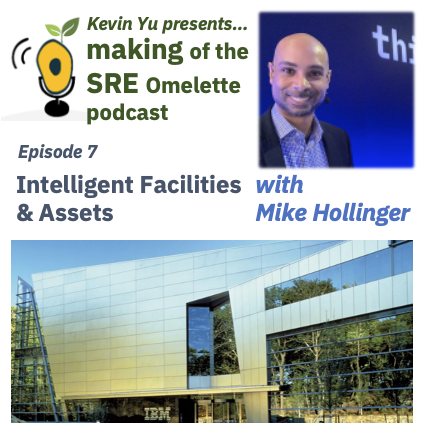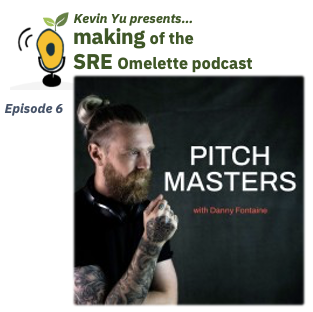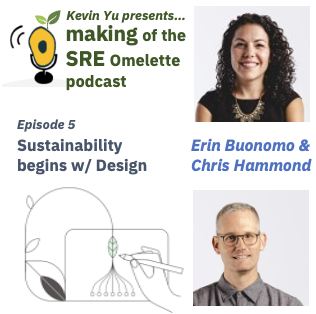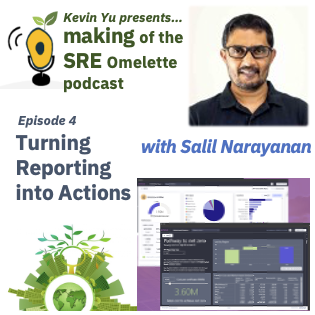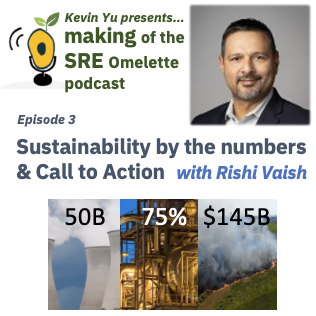Episode 5 - Recipe for Innovation
- 0.5
- 1
- 1.25
- 1.5
- 1.75
- 2
Steven Astorino: Area 631 was designed to allow people to come together. This becomes their day job. Think of it like a startup where that is your job day and night to make sure that you're innovating. And we eliminate also all the blockers.
Kevin Yu: Welcome back to another episode of the Making of the SRE Omelette Podcast, the show where we explore the positive business and client success from site reliability engineering and hear from experts on how they influence the cultural and mindset shift that led to those results. I'm your host Kevin Yu, and I'm the principal SRE at IBM applications. Today's episode is on innovation, specifically how a company can foster innovation and balance it with other priorities. Speaking to us on this topic is Steven Astorino. Steven is the VP of development for IBM data and AI and the IBM Canada lab director. Steven spearheaded the creation of a program called Area 631 in the Toronto lab. That was a game changer in how IBM looked at bringing innovation to life. The concept was so successful in Toronto that the program has since been launched at eight IBM software development labs. Welcome to the show, Steve.
Steven Astorino: Thank you. Thanks for having me.
Kevin Yu: So Steve, let's get right to it. Could you please explain to the audience what Area 631 is?
Steven Astorino: Sure. Area 631 is essentially six people, three months, one breakthrough, and it's really about creating an environment for people to come together and innovate. Typically, as you're working on your day to day, it's very hard to do that. You typically have assignments. You're very stressed with pressures of timelines and so on, so it's very hard to find that time. Area 631 was really designed to allow people to come together. This becomes their day job. So, think of a startup where that is your job day and night to make sure that you're innovating. And we eliminate also all the blockers for you. Being part of IBM, we call them blockers, but we have a lot of rules and procedures we have to follow and so on. So with Area 631, we eliminate that. There are really no rules. Break it or make it in three months. That's the idea behind it.
Kevin Yu: I think you will have many audiences for other companies also nodding their heads when you mentioned about processes. I was lucky to be a mentor and sponsor user in the very first 631 project. A quick shout out to the Log Prophet AIOps team. I was amazed at not only the velocity but also the quality of deliverables coming out. Could you please expand on specific problems you were looking for Area 631 to solve?
Steven Astorino: Yeah. Now at a high level, the problem that area 631 is solving is really about innovation. So when I took over as lab director a few years back, I was looking at different teams within the lab were fixing different problems. Actually, the same problem-
Kevin Yu: Reinventing the wheel.
Steven Astorino: Reinventing the wheel. Kubernetes, I remember at the time, we were just getting acquainted with it, and everyone was trying to innovate there. One of the things was to allow different groups from different business units to come together. So when we actually designed 631, it's developers or designers or product managers from different parts of the different business units. This allowed us to come together in one common goal but also share expertise, collaborate on problems that we're solving independently or individually, or like you said, reinventing the wheel. So, that allowed us to bring these people together and innovate. That was the primary one. The other one, like I said before, it's hard as you're doing your day- to- day job to break through and innovate on things unless you're doing that outside of your regular workday, which is very busy already. So creating an environment where it allows you to spend that time, I think that was differentiating as well. And probably the last thing is we created actual physical space, which is very unique, very different than anything you would see at IBM.
Kevin Yu: Yes.
Steven Astorino: Very agile in its own area with the six different environments, places to sit in, collaboration space, whiteboards, all of that is very cool. And it created that environment where people worked well together and had a physical space to do that at.
Kevin Yu: Yeah, it's definitely a very cool place to hang out. I think it's one of the coolest. I remember when we started, there was always snacks there.
Steven Astorino: Yeah.
Kevin Yu: It's good incentive for people to go there and collaborate and chat about inaudible
Steven Astorino: Yeah, 100%.
Kevin Yu: Could you give some examples of some of the successes that have come out of 631?
Steven Astorino: Sure. First one I think you were on was Log Prophet. That was one of the first ones that came out. There were many reasons why we picked that one, including some clients we were working with that really needed this capability. We called it Log Prophet initially, but it really was building some AI technology around end to end of monitoring a system to be able to predict an outage or problems coming up in the future. At the time, they were looking for something that automated their monitoring process to make sure they predict these types of failures or outages. So that was the idea behind that first one. It was very successful. It really took off. There was a lot of attention. And by the way, that became the Watson AIOps product and initially was like a mini- business unit that Arvind created. And now, it's part of the automation inaudible
Kevin Yu: It's huge.
Steven Astorino: Yeah.
Kevin Yu: It's led an industry- wide initiative around AI operations.
Steven Astorino: Yeah. So, it was very cool. That was one. Another one we did was in Germany as we branched off to different countries as you mentioned at the beginning.
Kevin Yu: Right.
Steven Astorino: There's a power rankings one.
Kevin Yu: That one's fascinating.
Steven Astorino: It's fascinating. Actually, that one made it on Forbes magazine as well-
Kevin Yu: inaudible Blizzard.
Steven Astorino: Yeah. It's really cool as well. But basically looking at, again, leveraging AI and looking at rankings of the players and so on. It provides insights, so it's really cool.
Kevin Yu: Yeah, no, that's interesting. Traditionally, people think about IBM operating the enterprise space. Here you are an innovation that can lead you to eSports.
Steven Astorino: Right. It's totally different. Yeah, absolutely.
Kevin Yu: No, that's fantastic. Could you share with the audience how you justify the investment of 631? You mentioned six people.
Steven Astorino: Yeah.
Kevin Yu: For three months.
Steven Astorino: Yeah.
Kevin Yu: How did you justify that kind of investment with your leadership team?
Steven Astorino: I can tell you at the very beginning it was hard, much harder. Then, as you see the success, it's much easier to get buy in and to get support. At the end of the day, it's really about innovation is core to us. It always has been, and we need to make sure that we make room for that and invest in it. Some personal fight for me to go and secure some of this funding, and we did that initially. And then, after Log Prophet, and then we started on the second one, it was much easier. But a lot of, basically, ask for favors and so on for different business units to contribute. The value was obvious afterwards, but that's how it worked. But then, now it's, again, in eight different countries or so, and everyone sees the value. Believe it or not, after the first few, we had people lining up that wanted to join the program.
Kevin Yu: Right, right.
Steven Astorino: Because it feels like you're breaking out of your day to day, and you're working on a new cool startup type of environment. So, people enjoy that.
Kevin Yu: For me, as you said, it was really good to break out the day- to- day routine. And I also had the opportunity to meet with people I otherwise wouldn't have. So, that was a great experience. Steve, want to take a minute to thank you on behalf of everyone who had, has, and will be able to experience this because you picked up that fight to make it happen. Thank you so much. Steve, you talk about the value of 631. Can you give some examples of it perhaps from the angle of both the business and tech vitality?
Steven Astorino: Log Prophet was one example. We also had some cloud projects that we did with an external startup incubator for our IBM cloud to make it easier to onboard. As an example, the idea here is after the three months, these projects essentially graduate. And once they graduate, we decide where they fit in and where they go. But typically, they end up in one of our business units improving one of our technologies or a feature of our technology or so on. So if it's a new idea, it's the starting point of something bigger for the future. If it's an existing solution and then it's an improvements to features, enhancements, we basically take that code, including the team sometimes, and we integrate it into the business units. So, the value's pretty obvious there in terms of the return on investment and what it brings to the table. I think it's something that's needed. It's working. It's a great model, and we've had lots of examples. One that we did is our sales configurator for all the Cloud Paks.
Kevin Yu: Oh, wow.
Steven Astorino: We started with Cloud Pak for data, and then all the Cloud Paks are adopting it now. But basically, give a tool for the salespeople to go in and figure out the licensing and the VPCs and the cost of everything. And because it's OpenShift and everything else, it's a complex matrix. So this, it's very simple. You make your selection. It tells you exactly what you need. It spreads out a spreadsheet with all the information, and it ties it into our sales tool as well.
Kevin Yu: Oh, wow. I laugh because VPC, it sounds like a sweet, simple acronym, but there's so much mass behind it.
Steven Astorino: Yeah, absolutely. Absolutely. So, that's another example. But the value is pretty obvious, so it's really good.
Kevin Yu: Thanks for sharing those fantastic examples. Let's pivot for a bit.
Steven Astorino: Yeah.
Kevin Yu: One of the purposes of this podcast is to drive the tech vitality of site reliability engineering. Many of the 631 projects involved solving problems in the operations domain. Steve, perhaps some words of wisdom to both current and future practitioners. What do you think are the next set of innovations needed by SRE?
Steven Astorino: I think automation is a big thing. Being able to automate the manual processes so that we can help our customers, that's definitely an important one. Security is another aspect of that. In terms of our customers, they expect 100% percent uptime. Forget the three nines, four nines, five nines, they're expecting 100%. So, anything that we can automate to make our job more reliable, the experience more reliable, the customer happier, all of those are critical. To me, it would be how can we automate the things that we have to do manually where as humans it's hard to stay on top of it on a consistent basis? Whether it's looking through logs and the volume and the amount and all of that stuff, looking for the right characteristics and behaviors and all of that, anything we can automate around that is a significant boost to our productivity and the experience of the customer.
Kevin Yu: I like it. Leverage automation to meet customer expectations, drive client success, and try and make it easier for us to run our business. So Steve, you took us through a great journey that captures the story of 631, its motivation, problems it's solved, as well as steps you took to make it real. In closing, let's go back to the inspiration of this podcast but switch it to innovation. What will be your ingredient and recipe to foster innovation at the workplace?
Steven Astorino: For me, one is we really need to make room in an environment for our people to be able to innovate. I think the biggest blocker we have is we're too busy. We can't be too busy to innovate, so we have to create that environment. I think that's probably the most important piece. The other one is it's okay to fail. We forget that sometimes. Everyone wants to try something and expect it to just work or be successful all the time. In fact, that's far from reality, far from what you should expect. Innovation is you have to fail many times before you succeed. So, that's the advice. I know that's what I do within my teams and with the programs I create. And by the way, there's a new program, I don't want to deviate, all of that, that I started last year called Hyper Blue.
Kevin Yu: Oh.
Steven Astorino: It's the next iteration or the evolution of the Area 631 project.
Kevin Yu: Oh, that's awesome.
Steven Astorino: And just to give 30 seconds on that, Hyper Blue, it's a true startup program where we invest as VCs into this. It's a Shark Tank- style type of setup. In fact, we record the shows like Shark Tank does. And yeah, we allow people to pitch their ideas, and then we decide if we invest. Last year we invested in seven, and they're actually all doing really well. They have clients, and we're starting to monetize on those innovations.
Kevin Yu: Wow, that's awesome, IT celebrities. I've got to talk to my agent to get myself on that show.
Steven Astorino: Absolutely.
Kevin Yu: So there you go, ladies and gentlemen, Steven Astorino, IBM VP, Canada lab director and champion of innovation at the enterprise. Thank you for joining us today.
Steven Astorino: Thanks for having me.
Kevin Yu: And I'd like to thank you, the audience, for listening. See you again on an upcoming episode.
DESCRIPTION
Innovation is core to organizational success and SRE. Steven Astorino, IBM VP of Development for Data & AI and the IBM Canada Lab Director describes the journey he took to accelerate innovation at IBM - Area 631. Steven shares the problems he observed, how he solved them and highlights the success from the program. The program started in IBM Toronto lab and has since grown to 8 other IBM lab locations. Steven also gives an innovation shout out to Site Reliability Engineers and recipe to accelerate innovation at the enterprise.
Today's Host
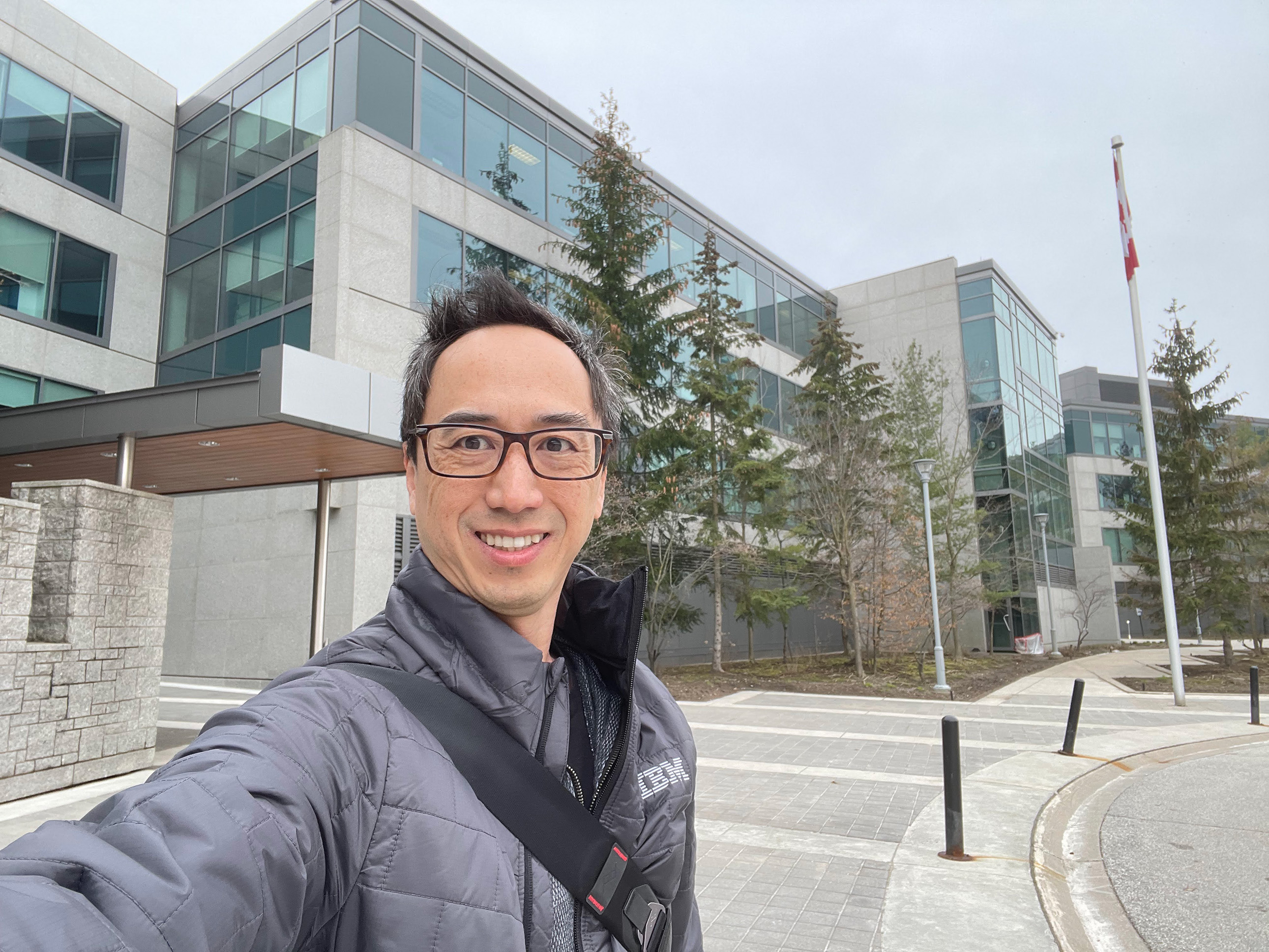
Kevin Yu
Today's Guests
